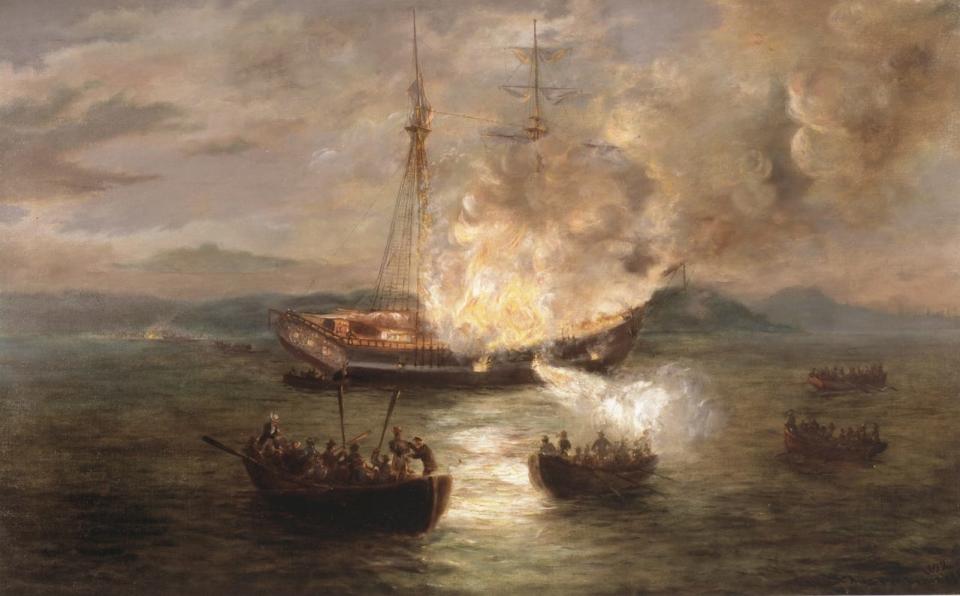Like Massachusetts and Virginia, RI was on the front line in the movement for independence | Opinion
Patrick T. Conley is the author of "Rhode Island's Contributions to the Founding of the United States" and was the chairman of the Rhode Island Bicentennial of Independence Commission.
The roles of Massachusetts and Virginia in the leadership of the movement for independence are well known. However, Rhode Island was also on the front line.
Prior to the burning of the Gaspee on June 9, 1772, nearly every colony expressed opposition to England’s imperial reorganization with petitions, resolutions and defiant, but petty, acts of vandalism. Rhode Island joined that crowd. In 1764, a colonial gunner at Fort George in Newport fired a warning shot over the bow of the St. John, a British customs schooner attempting to enforce the Sugar Act. In 1765, Newporters stole and barred a small tender from the British customs frigate Maidstone and rioted and assaulted Stamp Act officials. In July 1769, they seized and burned the schooner Liberty seized by customs officials from prominent Boston merchant John Hancock.
Amid these physical acts of defiance, Providence leaders Stephen Hopkins and Silas Downer defied Parliament by publishing pamphlets promoting the federal theory of empire, stressing local sovereignty, a theory that would have an influence on the framers of our Constitution.
On June 9, 1772, these annoying actions were eclipsed by what Rhode Islanders correctly call “the first blow for freedom.” On that evening, eight 12-man longboats led by Abraham Whipple rowed from Providence and another came from Bristol under Capt. Simeon Potter to attack an armed customs schooner named the Gaspee. That ship had run aground on a sandbar off the shore of Warwick. There raiders seized the English naval vessel; shot its commander, William Dudingston; removed the crew; and burned the Gaspee to the waterline. This was a daring attack on His Majesty’s Navy.

In August 1772, the king issued a proclamation denouncing the outrage, created an investigatory commission, and offered a £500 reward (later increased to £1,000) for information leading to the arrest and conviction of the perpetrators.
Beginning in January 1773, the royal Gaspee commission held hearings. Despite the huge reward for information regarding the rebel attacking force of approximately 100 men, no Gaspee raider was conclusively identified or charged. The commission adjourned reluctantly on June 22, 1773.
More: Want a Gaspee license plate and to help Gaspee Days? This could be your chance
The royal commissioners had been instructed to send any identified perpetrators to London for trial, clearly violating a basic right of English citizenship — the right to a fair trial in the place where the alleged crime occurred. An alarmed Chief Justice Stephen Hopkins wrote letters concerning this threat to legislators in other colonies proposing the establishment of formal committees of correspondence to deal in unison with such violations of American common law rights. Virginia replied by establishing a legislative committee of correspondence. The other colonies followed suit.
At the Providence Town Meeting of May 17, 1774, the town’s citizens issued the first call for a Continental Congress. When Pennsylvania and New York responded promptly and positively, the Rhode Island General Assembly made the colony the first to appoint delegates. On June 15, 1774, Stephen Hopkins and his political nemesis Samuel Ward were dispatched to Philadelphia to represent Rhode Island.
In 1775, Rhode Island’s defiance intensified. On March 2, 1775, Providence conducted its own tea party by burning 300 pounds of that valuable leaf in its Market Square. On June 12, 1775, Rhode Island established a colonial navy, the first of the Revolutionary Era. Then Stephen Hopkins introduced a bill in congress to establish a U.S. Navy, which passed on October 13, 1775. Its first ship was John Brown’s sloop Katy (renamed Providence).
More: What happened to the HMS Gaspee: First blood of the American Revolution or petty revenge?
On May 4, 1776, Rhode Island became the first colony to formally renounce allegiance to King George III — an act we now celebrate (with a little hyperbole) as Rhode Island Independence Day. That momentous day actually came on July 19 when the General Assembly ratified the Declaration of Independence.
In view of this scenario, Virginia and Massachusetts should share the spotlight with Rhode Island as the leaders in the campaign to create a new nation!
This article originally appeared on The Providence Journal: Burning of the Gaspee and Providence's own tea party were among the acts of defiance.

